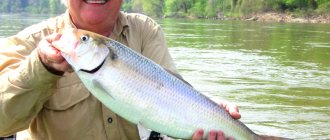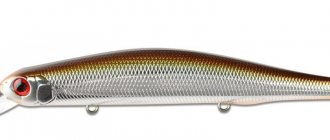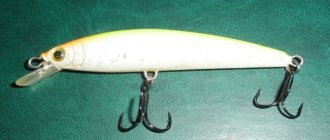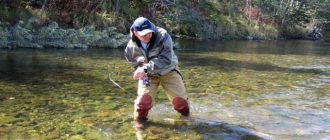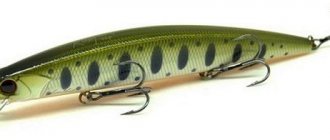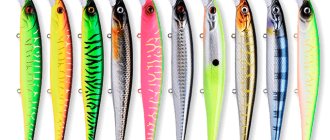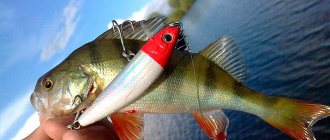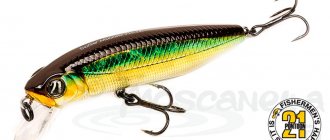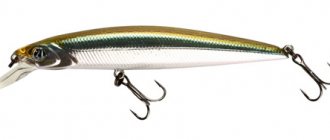Which brand of wobbler is better to choose?
The companies on the list produce effective fishing baits and tackle, which are used by many hunters for pike, carp, carp, catfish, and perch. These companies are the most trusted when purchasing the necessary goods for sport and recreational fishing.
- Rapala is a company from Finland, founded by an avid fisherman, that produces good equipment for fishing. In addition to lures and bait, the brand produces tools, fish scales, backpacks and bags, shoes, clothing, and accessories.
- Aqua - fishing products from a manufacturer from Russia are in demand due to the range, affordable price, and product quality. Since 1988, the company has been a leader in the domestic market in the production of wobblers, cords, rods, reels, balancers, and jigs.
- Itumo , a manufacturer from Korea, combines reasonable prices, stable quality, and good characteristics in its products. The brand's baits are designed for use in different weather conditions. Fishermen will catch the predator in still water, deep water, shallow water and in a body of water with a fast current.
- Namazu - the brand's fishing accessories are functional, convenient, and durable. A manufacturer from China produces wobblers, spinning rods, and fishing rods for buyers who do not want to spend a lot of money on fishing products.
- Chimera is a company that specializes in selling replicas of famous brands and produces high-quality fishing gear and accessories. The variety of models and colors of baits that are effective in rivers and lakes with different fishing conditions impress fishermen.
- Rubicon - for more than 10 years, the brand has been producing fishing rods, cages, landing nets, hooks, wobblers, silicone baits and other products for fishing in summer and winter. The company follows trends, offering current high-quality products.
- Smithwick has been competing with global brands for over 80 years. The baits have become favorites of several generations, they are durable, functional, and come in different colors. The company promotes products in different countries of the world, surprising customers with quality and range.
- Jackall is a Japanese company that has been planning, developing, manufacturing and selling fishing tackle for over 20 years. By testing products, the brand sends only worthy specimens for sale so that fishermen get a big catch and enjoy fishing.
- Yo – Zuri ( Duel ) – a brand headquartered in Florida (USA) has been known since 1997. Sells wobblers, hooks, braided cord, fishing line in nine branches. The company set a high price for the product due to its own developed technologies used in the production of products.
- Lucky Craft is a company from Japan that produces fishing gear for amateurs and professional athletes. Due to exclusive technical developments and constantly carried out scientific research, the quality of baits remains high for many years.
- O. _ S. _ P is a company from Tokyo (Japan), in which high-class fishermen and famous wobbler designers take part in the modeling and testing of its products. The brand tests products, improving the performance and aesthetic qualities of baits.
Features of pike fishing by twitching
Pike caught by twitching
There are some peculiarities when fishing for pike using this method. It is best to do this on swampy lakes and in the headwaters of rivers, and it does not matter whether you fish in the spring in March or in late autumn. Locations for fishing should have the following parameters: a slightly overgrown shore, a weak current, in lakes in places that are well warmed up by the sun. Such places are the most likely to find this fish.
Twitching fishing for pike proceeds as follows:
- Initially, you need to cast the bait not far from the shore, near the thickets in the reservoir.
- You don’t need to make any movements for about 5-7 seconds, you just need to let the wobbler drop a little.
- Since pike is a rather curious fish, it will definitely become interested in the bait, and it is at this moment that you need to start moving.
This method will allow you to get a bite literally in the first seconds.
Catching this fish involves longer jerks with a wobbler, along with short temporary pauses. When the predator is active, it is necessary to use the method of long jerks at intervals of 2-3 seconds.
Separately, it is worth mentioning the fishing technique in extreme heat, then the interval between jerks should be approximately 8-9 seconds. There are several effective tips from professionals that will help any angler when fishing for pike using the twitching method:
- the success of the catch will directly depend on the skill of controlling the wobbler, so training will be relevant;
- the twitching method gives maximum efficiency in calm and quiet water;
- During strong winds, fishing this way may not give the expected result.
Wobblers rating
The list of the best wobblers is compiled based on expert assessments and the results of many tests. The opinions of real buyers also did not go unnoticed. The following characteristics of the nominees were also taken into account when selecting:
- Material;
- Accessories;
- Size;
- Depth;
- Weight;
- Design;
- Game quality;
- catchability;
- Controllability on water;
- Additional options;
- Price.
A certain bait is suitable for each predator. Manufacturers produce different models, the properties of which affect catchability.
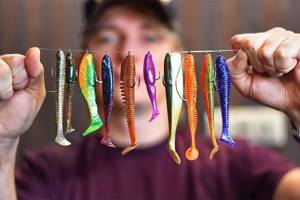
The best vibrotails
The best crank wobblers
Spinning fishermen use a bait of a special shape and size - a crank. This is an imitation of different types of animals, beetles, small plump fish with a specific body shape. Due to the large head and voluminous short body, the product actively plays, attracting a predator and provoking it to attack. The 3 best crank wobblers were selected based on the characteristics and functionality of 15 models, differing in size, shape, design, and price.
Rapala Dives-To
Rapala Dives-To wobblers have positive buoyancy due to the center of gravity shifted to the front. The immersion speed is increased due to the additional weight mounted in the blade. Because of this, the bait quickly reaches the working horizon of the wiring. Its length is 7 cm, weight – 22 g. The model is catchy when casting and trolling. Product material: balsa wood, polycarbonate blade. Plays actively at any speed, creating a crackling sound that attracts predators. The maximum diving depth of 5 m creates an additional opportunity for the fisherman to get a large catch.
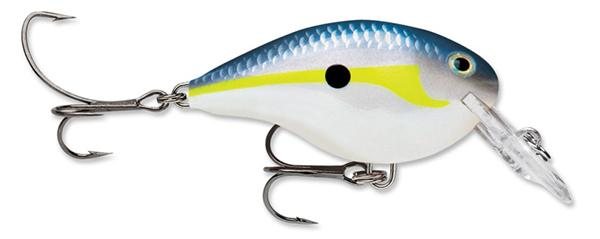
Advantages
- Built-in noise chamber;
- Design;
- Uniform wiring;
- Variety of colors.
Flaws
- The bait catches on the fishing line when casting.
According to user reviews, the Rapala Dives-To model catches always and everywhere. In clear or rainy weather, in shallow water, with fast currents, large fish are caught in muddy water. It is convenient to fish a large sector from one place due to its weight.
Aqua Bit 40F 018
A manufacturer from Russia has released a bait for all-season uniform fishing for rudd, ide, chub, and perch. The floating crank weighs 2.5 g and is 4 cm long. This is the smallest model for ultralight rods with a depth of 0 - 1 m. It imitates the game of a fry that attracts a predator. Due to the metal balls in the body, an additional acoustic effect is created in shallow water. Perch actively reacts to sound, starting the hunt for bait. There are two triple hooks made of durable metal on the tail and belly; by swallowing them, the fish firmly rests on the rod. The hologram effect in the color of the model additionally attracts the predator.

Advantages
- Design;
- catchability;
- Maneuverability;
- Uniform fishing technique.
Flaws
- Quality of material.
Owners of the Aqua Bit 40F 018 crank talk about the poor quality of the material. It is easily bitten by the sharp teeth of fish and becomes unusable after several uses. Despite the good catchability, the price of the model is high; not everyone can buy a crank wobbler.
Itumo Hydro Jack 40SP
The Itumo Hydro Jack 40SP product is made of durable plastic with a paint coating that is resistant to mechanical damage and other physical impacts. The body is equipped with an elongated blade with a fishing line mount and two triple hooks made of high-quality metal. The crank size is 40 mm, weighs 5 g. It is used in rapid flows of stormy rivers and mountain streams at a depth of up to two meters. Not suitable for calm waters. The model is effective in any direction of current flow due to the stabilizing hole on the blade. The manufacturer has provided a variety of colors for catching different breeds of predators that are attracted by the sound made by the product.
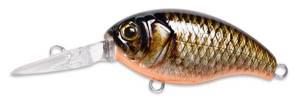
Advantages
- Noise chamber;
- Stable game;
- Effective with uniform wiring and soft twitching;
- Variety of colors.
Flaws
- Water enters through the eyelet hole and the wobbler sinks.
According to user reviews, baits are sold in boxes that protect from mechanical impact. The manufacturer installs high-quality fittings and sharp hooks on them.
Fishermen note a variety of colors that no other brand has.
Wobblers for small rivers
I propose to talk about wobblers for small rivers. At first glance, the topic is simple, but this is not entirely true. Imagine typical rivers of the Kola Peninsula, Karelia, the North Caucasus or central Russia. They are all very different in the appearance of the banks, and in the strength of the current, and in the temperature of the water in them, and in the bottom topography. And, most importantly, they are inhabited by fish of different species. It is clear that the contents of the wobbler box for the Karelian Isthmus and for the Moscow region should be different.
Small pike river in the middle zone with a weak current

The description of the river includes two main factors that should be taken into account: a weak, sometimes symbolic current and a predominantly pike population. A weak current determines not only the nature of the banks and the profile of the channel, but also the type of wobblers used. Basically, these are the same baits that are used to catch pike in shallow lake waters; by depth level - from surface and subsurface to mid-deep-water, going at a depth of just over 1 m. When the conversation turns to size, I remember the words of one famous fly fisherman: “It’s difficult to scare a pike with its size!” I would develop this idea this way: “It’s easier to scare an angler with size.” If you have a prejudice against large baits, fish with minnow wobblers of the most popular “golden” size - from 70 to 90 mm. If there is no prejudice, then 130 mm is not an obstacle to successful catching of river pike. Moreover, this size does not frighten even an outright trifle.
Small rivers of Karelia and the Karelian Isthmus
They have cold water, a mixed fish population, different current strengths within the same river: from quiet water to real rapids, as well as significant fluctuations in water levels depending on the time of year. The size of the wobblers depends only on whether you will catch only pike or try to catch other species of fish. When catching a variety of predators, you have to limit the size of your bait. For most rivers, I set this limit for myself at 70-80 mm. The only exception is when catching a completely unafraid predator in remote places.
From these two particular examples, it can be understood that the set of baits should allow you to adapt to the target predator, characteristic depths and currents of varying strengths. Moreover, the latter is the most interesting task. I will try to explain my approach to this issue.
I’m not going to advocate for specific models of lures, but will simply tell the story of how I got acquainted with them and the reasons why they lingered in my river box, and at the same time how these lures influenced my approach to selecting wobblers for a small river. To complete the picture, at the end of the article you can familiarize yourself with the contents of the box of Moscow expert Alexander Ryzhov, who fishes in conditions significantly different from mine.
Read: Fishing in the Sayan Mountains
My arsenal for fishing on these rivers necessarily includes three types of wobblers.
1. Wobblers with a fat body shape
This is probably the first type of wobblers to which river specialization has been assigned. According to an already established tradition, they are distinguished into a separate form of fet. But if you want to look for lures of this type in Japanese catalogs, the name often contains the more general term “crank”; the Japanese use the word “fat” very rarely. In my opinion, separating “fat people” into a separate category is quite justified. Because fat is not only a pot-bellied body with a shoulder blade, but also an intense game constructively connected with this body. The most obvious consumers of “fat” wobblers in our rivers are “white” predators, trout and perch. For pike we often use jerk baits, but there are many situations in which fat baits are very effective. So, when hunting for pike, you shouldn’t forget about them.
Perhaps the first to become popular among us and the most recognizable representative of this family is the Salmo Hornet, which is available in many sizes, colors and with different buoyancy. It holds the current well and is equally attractive to different predators. Suitable for fishing in rivers in almost any season. The main disadvantage of this wobbler is its low mechanical strength. The hard foam from which the body of the bait is made is easily chewed by pike teeth and broken on stones. Because of this Salmov foam, the term “Polish technology” even appeared. Hornet spawned a number of copies and imitations, including those in plastic that is more familiar to us. In addition to Salmo Hornet, there are many successful and original fat-shaped baits from other manufacturers: ZipBaits Hickory, Pontoon21 Red Rag, Chubby and Cherry from Jackall and many others. In general, plastic technology, unlike Polish technology, allows you to equip the bait with several additional properties at once: from noise balls to a long-distance casting system.
My acquaintance with fats began with Salmo Hornet and dueling wobblers of the ultralight class. I quickly moved away from the ultralight when catching wild river fish, but I liked the 4-centimeter “pole” so much that I began to purposefully look for baits similar in shape and size. Now in my river box there are always a couple of fats measuring about 4 cm or a little more.
For what reasons have fats become a mandatory part of my arsenal? The main thing is the combination of compact size with very intense play. Sometimes it is even compared to the work of a jackhammer. When fishing on rivers, this game makes it possible to use very slow retrieves, up to a complete stop. That is, the wiring is stopped for a few seconds, and the bait continues to work under the influence of the current. I highly recommend trying it. If you are fishing for pike in a river with a very weak current, then taking fats with you or not is a matter of personal preference. Many fishermen, in the wake of the craze for jerking lures, have learned to completely do without “fat” wobblers.
Read: Winter spinning. Secrets of successful fishing
2. Wobblers with a deep-sea blade, also known as “deeps”
We will talk about wobblers with a depth of no more than 3 m. Firstly, large depths on small rivers are rare, and secondly, in the current, wobblers with a depth of more than 3 m will have too much drag when retrieved. At first, some experts considered the fashion for deep-sea wobblers to be a product of advertising, but now everything has fallen into place, and deeps have taken their rightful place in spinners’ boxes.
My acquaintance with them took place more than ten years ago. Initially, they seemed to me to be purely “track” baits, and this is not my thing at all. But curiosity made me buy about five different dips. I planned to wade them in lakes on the Karelian Isthmus. As a result, I adapted to fishing with deep-sea wobblers in still water for almost a whole season. But on a small river it is much easier to master dip fishing. These lures have three qualities that are useful for spinning anglers.
• The first is the wiring horizon. The fish is not always inclined to attack the bait moving on top.
• Secondly, with a large, almost horizontal blade, they “cling” well to their wiring horizon, including on a short cord almost under their feet. This is important when fishing from high banks.
• Third, a side effect of the depth of the stroke, which is that dips allow the spinner to be more invisible to the fish when fishing at a short distance.
Nowadays my river box usually contains four different sized dips. Unlike fats, they have a less intense game, so with the same rod I can comfortably control both 4 and 8 cm wobblers. And thanks to the different sizes, it becomes possible to more accurately adapt to a specific predator. And even if there are no areas with truly deep water on the river, then a couple of dips with a depth of up to 2 m will still not be superfluous. On a thick cord and with a short release of 2 m, they still won’t dive, but you can move the bait right to the very bottom.
3. Minnow wobblers with their own game
The stronger the current, the less appropriate are classic jerk minnows with a small blade. Sideways movements during the jerk are smoothed out, and the point in using aggressive twitching is lost. If the playing wobbler is sinking or has minimal buoyancy, it is much easier for it to maintain the wiring horizon on the stream. One of the most famous representatives of this subspecies is Yo-Zuri L-Minnow. The large blade, set at a steep angle to the body, gives this wobbler a noticeable action of its own. And the light, unloaded tail gives this game a fairly large scope. In combination with negative buoyancy, this turns into a killer bouquet for river predators. Available in three sizes: 33; 44 and 66 mm. Lures of size 44 and 66 mm are firmly “registered” in my river box. Recently, the manufacturer expanded its model range by releasing even heavier Heavy Weight models.
Read: Castmaster spinner: versatility, catchability and features
This wobbler is known for the ambiguous attitude of domestic spinning players towards it. The range of opinions is wide: from complete delight to absolute indifference. To get to know the Elka correctly, I recommend just trying it on a small river.
In a floating version and in a version with neutral buoyancy, there are replicas from third-party companies, for example, under the name Humbug Minnow. They are not an exact copy; rather, they are a free interpretation of the L-Minnow theme. Good for standing water, but less effective on rivers than the sinking originals from Yo-Zuri. A successful representative of this subspecies is the shallow-water version of the Crack Jack wobblers from Pontoon21. “Jacks,” unlike the ascetic “Eleks,” have a very wide range of colors and are equipped with a magnetic long-casting system. Size range: from 38 to 98 mm.
It is clear that minnow wobblers are necessary for fishing in small rivers. But they are also irreplaceable on deep rivers. For reasons that are not entirely clear to us, on some days the fish almost completely ignores the deeps, but at the same time easily rises from the bottom behind shallow minnows.
I’ve had fishing trips where deeps lost in the number of bites in a ratio of 1:4. so the “fry” do not leave the river box at all. My standard set of minnow wobblers today is four to six lures measuring 44-90 mm. I don’t use larger baits in fast water, because this size range cannot be covered with one spinning rod.
In addition to the established set of wobblers, there is always something else in my box in single copies. Sometimes these are new items, sometimes they are wobblers of completely different types (for example, rattlins and joints) for which I am also trying to find application on the river.
As a result, a set of about 15 wobblers emerges, with which I can go not only to my “home” reservoir, but also to explore a new river. It is clear that all of them will not be used on one fishing trip. But even with a very good knowledge of the reservoir, it is difficult to predict in advance what a predator will peck at today. So, alas, a couple of wobblers are not enough. But you don’t need a hefty box of bait on the river either. I hope that all of the above will make it easier to assemble your personal wobbler box for a small river and help you avoid extremes.
Wobbler fishing River
The best wobblers Rattlin
A flat, sinking wobbler without a blade is characterized by vibration when retrieved. At the top of the head there is a plane that creates persistence in the water column. Like most lures, they are made of plastic. Metal balls are placed in their body cavities to create noise when the bait is played, similar to a baby rattle. In this nomination, 2 of the best Rattlin wobblers were selected in terms of design, catchability, and functionality.
Jackall Re/70
The sinking bladeless wobbler Jackall Re/70 is the choice of beginners and professional fishermen who want to fish any horizons of reservoirs. The bait is made in the form of a small fish made of plastic with a metal nose and forehead, which fix its position during retrieval, acting as a load. They protect it from damage when hitting a rocky bottom. There is a lead weight in the belly of the wobbler, which makes a specific sound when reeling, which is easily detected by the predator. Weight of 16 g provides good flight characteristics, allowing for accuracy and casting distance.
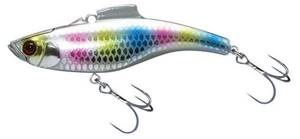
Advantages
- Powerful swivels;
- 2 treble sharp hooks;
- Suitable for winter and spinning fishing;
- Plastic top fin to stabilize the ride.
Flaws
- Price.
A wobbler for 1000 rubles is an expensive pleasure that only a keen fisherman can afford. By purchasing it, you can be sure of your catch.
Large perch, pike perch, and pike willingly take the hook when they hear the sound of the bait and see it play at a great distance.
Yo-Zuri Rattl'N Arms Vibe F307
A brand from Japan offers a Yo-Zuri Rattl'N Arms Vibe F307 trolling wobbler made of high-strength plastic. The product is resistant to mechanical damage and is used in freshwater and salt water bodies at a depth of up to two meters. Model length – 65 mm, weight – 17 g. Wobbler without a blade, but with noise balls inside to attract the attention of large fish. They provide casting range and stabilization in flight to prevent hooks from overlapping the fishing line. Sharp hooks adhere well to prey, preventing it from escaping. With uniform fishing near the bottom, wavy and stepped, you can catch perch, pike perch, ide, chub, and pike.

Advantages
- Hooks made of vanadium with a chemically sharpened tip;
- catchability;
- Manky game;
- Variety of colors.
Flaws
- The fish quickly eats the bait.
Reviews about the Yo-Zuri Rattl'N Arms Vibe F307 bait are positive. Fishermen note that large fish are caught even at dusk when fishing smoothly with short pauses. If you remove the hook from the belly, the model catches less grass from the bottom, and this will not affect the game.
The best vertical wobblers
The bait for winter ice fishing is a vertical sinking wobbler that does not have a blade. They are divided into fast and slow-sinking depending on the weight of the product. Manufacturers equip them with two treble hooks, rarely doubles or single hooks. They are popular because of the convenient attachment at the top of the fish’s body, as well as the possibility of using a wobbler in winter and summer. The rating of wobblers for ice fishing is based on the studied characteristics of more than 17 models.
Lucky Craft Sammy 115 F
The body of the bait is elongated with a bowl-shaped head in the upper part of the body and takes a vertical position after stopping. The head remains on the surface, creating an additional splash. Fishermen use the smooth movements of the product to attract predators, characteristic exclusively of the Lucky Craft Sammy 115 F model. The wobbler, 11.5 cm long and weighing 18.5 g, attracts the attention of pike, perch and other large predatory fish. The dimensions of the product do not prevent it from penetrating the wind well when casting. In flight it does not tumble, hitting exactly the right casting point.
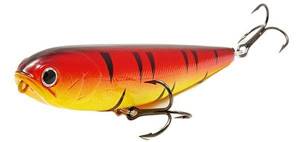
Advantages
- Good flight qualities;
- Works with waves and currents;
- 2 treble sharp hooks;
- Attractive to predators.
Flaws
- The quality of the material depends on the color.
According to fishermen, the Lucky Craft wobbler is effective when a predator feeds on the surface of the water. It is suitable for beginners and advanced spinning players because it is clear and easy to learn. A wobbler can be used to catch fish of different weights and species in calm reservoirs and fast-flowing rivers.
OSP Daibuzzn Heavy Hitter 64F
The floating model OSP Daibuzzn Heavy Hitter 64F is designed to attract large fish in poor visibility conditions. The wide body with flattened sides and tungsten balls at the bottom add intensity to the game. The thin plastic blade is located vertically relative to the body of the product - it protects from grass and obstacles and creates additional vibrations. The model is used at a depth of up to 0.3 m, cast into vegetation underwater to see the reaction of a predator to a bait of bright, attractive colors. Pike, perch, and pike perch instantly respond to the active play of the wobbler, and two triple sharp hooks tenaciously hold the catch.
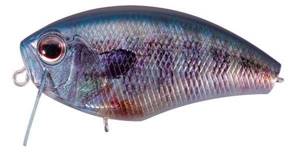
Advantages
- Works well in shallow water;
- Technology to lighten the body by 40%;
- Length 64 mm;
- Weight 17 g;
- The price is about 300 rubles.
Flaws
- The quality of the hooks is poor.
The OSP Daibuzzn Heavy Hitter 64F works well in muddy water or areas where duckweed and grass accumulate. Feedback from fishermen speaks of the interesting play of the bait and the reaction of a predator to it in shallow water. The wobbler creates powerful vibrations, increasing the chances of a catch.
Selecting a spinning rod
When choosing a spinning rod that is optimal for fishing with the Pontoon21 Cablista 125 SMR, keep in mind that not everything is simple here. Much depends on your preferences and habits (if you have any) and the fishing conditions in the pond. There are several basic options.
Along with typical twitching models, I sometimes use an ultra-fast action rod with a powerful butt and a sensitive flexible tip (rods of this type are usually called Magnum Taper in international fishing literature) with a test weight of 10.0-26.0 g or a little more. This spinning rod is ideal for fishing in the current for a specific retrieve of the Pontoon21 Cablista 125 SMR at a medium and slow pace, when the game is dominated by various pulls and smooth jerks. Thanks to the flexible top, you can diversify the pattern of play on pulls of different nature. I will return to this moment and tell you more about it. Such postings are effective when a predator responds well to its own bait play. The number of jerks in this case should be less than the number of pulls or accelerations. Depending on the speed of reeling and the duration of pauses, you can catch both an active and passive predator. In the latter case, it is necessary to use the neutral version of Pontoon21 Cablista 125 SP-SMR, carry it out with smooth accelerations, light jerks and long pauses. When playing this way, the wobbler moves imposingly, the game is dominated by various rolling vibrations, and on rare jerks it clearly moves to the sides and, swaying, freezes.
As for classic rod models, I advise you to pay attention to the Pontoon21 Seven&Eleven SES 7116F spinning rod with a test of 9.0-28.5 g or St.Croix LTES 70MHF2 with a test of 10.0-28.0 g. They fully correspond to the parameters of a wobbler.
I mentioned another possible option above: you can use a super-fast action spinning rod, the blank of which has the required rigidity along the entire length, including the tip, which should not easily fall during jerking. Because of their high sensitivity and reliability, spinning rods are nicknamed “pegs.” Their length is usually from 1.98 m to 2.30 m, so that it is convenient to perform twitching wiring with only the hand, otherwise during the whole day you can swing your forearm so much that by the evening your hands will fall off. For the same reasons, you should not use too powerful a spinning rod; a rod with a real test weight of 10.0 to 26.0 g maximum is suitable. Despite the fact that the Cablista 125 SP-SMR has a certain resistance in water and its weight is 20 g, a properly selected spinning rod with an ultra-fast action can effortlessly cope with any wiring of this wobbler.
Read: Lure-wobbler
It is important to feel the strength and amplitude of the jerk, both light and stronger. Due to the rigid tip of the Pontoon21 Cablista 125 SMR spinning rod, it instantly reacts to any movement of the rod, and the final result largely depends on how you control the wobbler.
I can recommend an excellent spinning rod from the Megabass company - Destroyer Blizzard Bull Barrel BBBS 762MMHMT with a test weight of 10.5-26.0 g. It is quite light, comfortable to fish with, and landing fish is a pleasure.
Pontoon21 Cablista 125 SMR is most effective in medium and large reservoirs, where shallow depths, various irrigations, underwater capes, spits and various bays prevail. As a rule, in such places large fish, the search and catch of which we are interested in, are often found.
Don’t forget about small bodies of water, including those in or near the city. Many local spinning anglers are focused on catching small pike or perch and do not pay enough attention to catching decent fish. A large wobbler in such reservoirs can give you a pleasant surprise.
The rule that where the fry is kept, there is a predator, works almost always. Therefore, it is very important to find schools of “white” fish and determine at what depth they stand. The predator pays increased attention to such a horizon and most willingly bites there. The depth of the neutral version of Pontoon21 Cablista 125 SPSMR is 1.6-2.0 m, and the floating Cablista 125 F-SMR is 1.5-1.8 m. By alternating these models, the speed of their movement and the duration of the pause, you can bait in the required layer. And if the pike stays in somewhat greater depths, then it’s okay: in many cases it is still able to rise and bite. By experimenting with wiring, you always have a chance to choose one that the predator will not refuse.
Read: Fishing with crank wobblers
Combined twitching of jerks and stretches
This method of play is suitable for catching fish in a variety of situations. Various pulls must be performed with the tip of the rod and alternate them with jerks, the number of which should not significantly exceed the number of pulls.
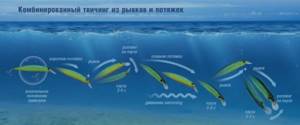
If you are catching an active predator or intend to fish a wide area of the reservoir, you need to perform longer and faster pulls at an average reel speed. When fishing in cold water and the predator is passive, a more careful fishing style and slow pulls are used.
I promised to dwell on this interesting point in detail. So, the pulls are different and the spinning rods used are different, these factors influence the behavior of the wobbler. The easiest way is to pull with a few turns of the reel handle. A wobbler will behave in approximately the same way if you pull it with a rod at a constant speed.
The performance of the wobbler will be different if the movement starts slowly, then there is a slight acceleration. At this moment, the bait actively vibrates, and the tip of the rod bends under load. Now you need to slow down and stop the movement and wait for the tip of the spinning rod to straighten naturally. Thus, it will allow the wobbler to stop very smoothly, which often causes an immediate bite. It is very difficult to perform this technique with another rod (not having a Magnum Taper design). Keep this detail in mind when you need special wiring items.
Twitching with various jerks
This wiring is the most successful and is familiar to many in one form or another. Its essence lies in alternating one or more jerks with pauses. Occasionally you can do short stretches or accelerations.
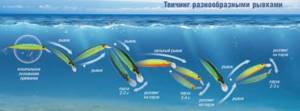
If the transparency of the water allows, watch how the bait plays after this or that action, remember after what movements the bite occurred. Having decided to perform a certain wiring pattern, carry it out from the beginning to the end of the distance.
During twitching, the Pontoon21 Cablista 125 SMR slides in one direction or the other. And after a sharper jerk, it deviates more to the side and slowly sways.
I don’t advise you to get carried away by playing too aggressively; in most cases this is not required, and sometimes it’s even contraindicated. After all, when using a large and fairly noisy wobbler, a predator will notice even the slightest game. Pontoon21 Cablista 125 SMR is a wobbler capable of much, including catching a trophy!
Fishing with a wobbler
Which wobbler is better to buy
A good wobbler is the key to a big catch. The models are suitable for different weather conditions, reservoirs and fish species and differ from each other in size, weight, color, additional elements and functionality.
Experts have identified several of the best wobblers;
- A wobbler from a Russian manufacturer, Aqua Bit 40F 018, costs about 150 rubles, but it is maneuverable and catchy. In shallow water, perch, chub, and rudd actively react to it, attracted by the iridescent colors;
- The design of Rubicon Twich Minnow F lures will impress the advanced spinning angler. A beginner in the world of fish hunting will be able to get an impressive catch with semolina with a clear action and strong, sharp hooks;
- Rattlin Yo-Zuri Rattl'N Arms Vibe F307 is a godsend for those who like to cast a rod into the distance of a fresh or salt water body. Large fish bite in response to the bright game and sound of the bait;
- The vertical wobbler OSP Daibuzzn Heavy Hitter 64F is good in muddy water or in places where underwater vegetation accumulates. Interested in the game and colors, the predator will quickly become a fisherman's catch.
After studying the rating of wobblers, you can choose the right bait for different fishing conditions. Based on the availability of a suitable fishing rod, finances, and also what kind of fish you want to catch, the bait will be a real assistant in achieving your goal.
